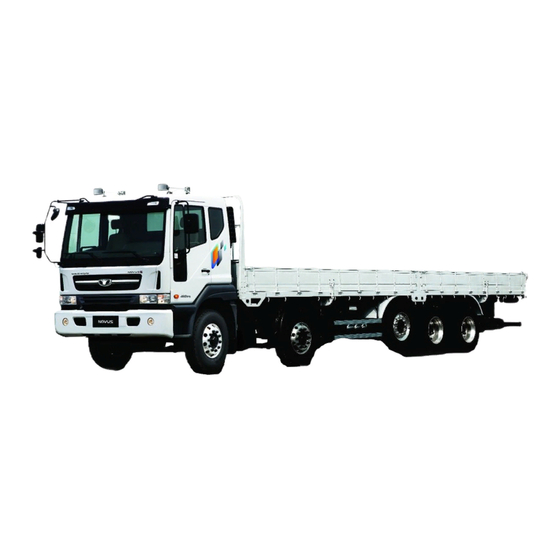
Table of Contents
Advertisement
Quick Links
We would like to take this opportunity to thank you for choosing a TATA
DAEWOO product and assure you for our continuing interest in your
motoring pleasure and satisfaction.
This manual has been prepared to acquaint you with the operation and
maintenance of your new TATA DAEWOO TRUCK and to provide
important safety information. We urge you to read it carefully and follow
the recommendation to help assure the most enjoyable, safe and
trouble‐free operation of your vehicle.
When it comes to service, remember that your TATA DAEWOO dealer
knows your vehicle best and is interested in your full satisfaction.
This manual should be considered as a permanent part of your vehicle,
and must remain with the vehicle at the time of resale.
All information, illustrations and specifications contained in this manual
are based on the latest product information available at the time of
publication.
The right is reserved to make changes at any time without notice.
https://www.truck-manuals.net/
FOREWORD
FOREWORD
TATA DAEWOO COMMERCIAL VEHICLE
Advertisement
Table of Contents
Troubleshooting

Summarization of Contents
1. HOW TO HANDLE THE VEHICLE
1. OPERATION OF NEW VEHICLE
Instructions for breaking in a new vehicle, including oil changes and engine warm-up procedures.
2. OPERATION OF CAB TILT
Procedures for tilting the vehicle's cab for access to components.
3. OPENING OR CLOSING OF FRONT LID
Steps for opening and closing the vehicle's front lid for access.
4. INSTRUMENTS AND CONTROLS
Overview of the vehicle's dashboard instruments and controls for operation.
2. DRIVING
1. BEFORE STARTING THE ENGINE
Essential checks of engine oil, clutch fluid, and washer fluid levels before starting.
2. STARTING AND STOPPING THE ENGINE
Procedures for starting and stopping the engine, including cold weather and DDC engine specifics.
3. BEFORE DRIVING OFF
Pre-drive checks including steering, brakes, wipers, and instrument panel indicators.
4. WHEN DRIVING OFF
Steps to follow before moving the vehicle, including air pressure and parking brake checks.
5. DRIVING FOR ECONOMY
Tips for economical driving, such as avoiding hard acceleration and maintaining tire pressure.
6. WHILE TRAVELING
Guidance on monitoring vehicle operation while driving, including warning lamps and temperature.
7. TRAVEL ON HIGHWAY
Specific considerations for driving on highways, including tire checks and speed perception.
8. OPERATION AND CARE IN HOT WEATHER
Maintenance and operational advice for vehicles operating in hot weather conditions.
9. OPERATION AND CARE IN COLD WEATHER
Maintenance and operational advice for vehicles operating in cold weather conditions.
3. INSPECTION AND MAINTENANCE
1. DAILY CHECK BEFORE DRIVING
Daily checks required for safety and dependable operation before driving.
2. PERIODIC INSPECTION AND MAINTENANCE
Scheduled maintenance tasks for various vehicle systems like engine, transmission, and brakes.
3. PERIODIC INSPECTION CHART
Chart detailing periodic maintenance intervals for DDC engines and general vehicle components.
4. IN CASE OF EMERGENCY
Procedures for emergency stopping, starting, towing, and handling vehicle breakdowns.
5. VEHICLE REPAIR
Guidelines for vehicle cleaning and polishing to maintain appearance and condition.
4. TROUBLESHOOTING AND CORRECTIONS
1. ENGINE AND RELATED PARTS
Common engine problems, their causes, and recommended corrections for issues like starting and overheating.
2. CHASSIS AND RELATED PARTS
Troubleshooting for chassis issues like abnormal noises, steering problems, and brake actions.
3. ELECTRICAL
Troubleshooting for electrical system issues such as battery discharge and non-functional lamps.
4. DUMP
Troubleshooting for dump system problems like vessel height, raising smoothness, and oil line issues.
5. MISCELLANEOUS CONTROLS AND OPTIONS
1. TACHOGRAPH(option)
Information on the tachograph's construction, reading records, and handling procedures.
2. AIR SUSPENSION SEAT(option)
Instructions on adjusting the air suspension seat for driver comfort and posture.
3. AUTO GREASER(option)
Details on the auto greaser system, including operation, control unit, and grease replenishment.
4. TURBO CHARGER
Information on turbocharger operation, types, vehicle operation tips, and care procedures.
5. ZF TRANSMISSION
Construction, power flow, pneumatic control, and operation of ZF transmissions.
6. OPERATION OF DUMP SYSTEM
How to operate the dump system, including pre-operation checks, raising/lowering the deck, and cautions.
7. OPERATION OF TRACTOR-TRAILER
Driving techniques, connection procedures, and precautions for operating tractor-trailers.
8. BULK CEMENT TRACTOR
External views and specifications of the bulk cement tractor.
9. SELF STEER
Maintenance and troubleshooting procedures for the self-steer system.
10. HYDRAULIC DEVICE FOR CAR CARRIER
Circuit diagram, operation, specifications, and maintenance of the hydraulic system for car carriers.
11. TOOL LIST
List of tools provided with the vehicle, including their names, quantities, and applicable models.
12. SERVICE ELECTRIC EQUIPMENTS FOR USER
Information on user-installable electrical equipment like phone chargers and working lamps.
6. SPECIFICATIONS AND SERVICE DATA
1. LOCATION OF CHASSIS NUMBER AND ENGINE NUMBER
Locating the vehicle identification, chassis, and engine numbers for service and parts.
2. MAIN DATA
General specifications including dimensions, weights, and performance data for various models.
3. RECOMMENDED LUBRICANTS
Recommended fluids and lubricants for engine, transmission, axles, and other systems.






Need help?
Do you have a question about the Novus K4DEF and is the answer not in the manual?
Questions and answers